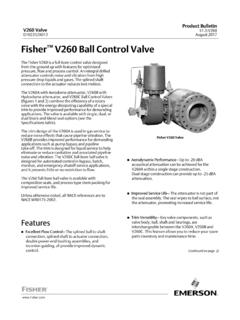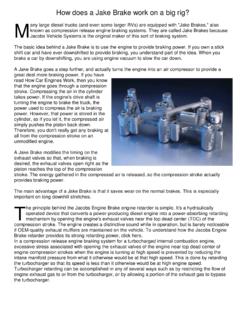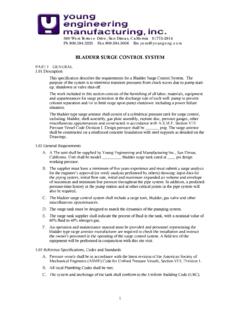Transcription of Energy Dissipation Mechanisms in Water Distribution Systems
1 Proceedings of FEDSM 03 4th ASME_JSME Joint Fluids Engineering Conference Honolulu, Hawaii, USA, July 6-11, 2003 FEDSM2003-45244 1 Copyright 2003 by ASME Energy Dissipation Mechanisms IN Water Distribution Systems Bryan W. Karney and Yves R. Filion Dept. of Civil Engineering, University of Toronto, Toronto, Canada. ABSTRACT: An important issue in the context of design and analysis of a Water Distribution system is the rate of Energy Dissipation of a transient disturbance. In this paper, a preliminary numerical investigation is undertaken to establish the role and significance of primary Energy Dissipation Mechanisms commonly found in Water transmission and Distribution Systems .
2 The role of steady friction, unwanted leaks, topological complexity and surge control devices in the decay of transient Energy is preliminarily investigated. An Energy approach previously derived is reviewed and used to track the progress of Dissipation in a system. Transient simulations are run on a hypothetical series pipeline and Distribution network with a waterhammer simulator to explore the dissipative effectiveness of some of the primary Mechanisms . INTRODUCTION The interchange and Dissipation of mechanical Energy during any dynamic process is a challenging, insightful and, sometimes, problematic phenomenon.
3 Energy losses must usually be bought from external supplies, often at significant financial and environmental cost. Yet, almost as often, the same Dissipation Mechanisms play an essential and positive role in system control, allowing dynamic conditions in the system to be stopped, adjusted, mitigated or deflected. Typical of such conversion processes are the hydraulic losses in a control valve, the heat associated with friction losses when a car's breaks are applied, or the distributed pressure drop in a pipe or conduit. Overall, Energy Dissipation plays a dual role, both helping and hindering system performance and behavior, and it is critical that analysts account for the dialectical nature of mechanical Energy losses.
4 Of particular importance in the current context is the fact that hydraulic conditions in most Water Distribution networks are in an almost constant state of change. Various users are continually adjusting their flow requirements, valves are frequently being adjusted and pumps are often switched on and off. Yet, despite this never-ending activity, hydraulic conditions are frequently well behaved; transients tend to decay rapidly as the system moves between near steady states. Moreover, the superposition or overlap of transient events is seldom required by designers or justified by analysts. The obvious implication is that there are many important and effective conversion and Dissipation Mechanisms taking place during the dynamic evolution of conditions in a Water Distribution network.
5 Historical Perspective Recently, numerous researchers have studied the Energy conversion and Dissipation Mechanisms that operate on a pipeline-fluid system during waterhammer conditions. Karney [1] developed an Energy expression to track the conversion of fluid kinetic Energy to elastic (internal) Energy and back again, as well as work and mechanical- Energy Dissipation interactions in a pipeline. Kung and Yang [2] adapted the Energy expression developed by Karney [1] to simulate Energy processes and interactions in a simple hydropower system comprising a penstock, surge-tank and throttling valve at the downstream end.
6 More recently, Ghidaoui, Karney and McInnis [3] have adapted the Energy expression to quantify discretization errors and Energy Dissipation levels associated with wave speed adjustment, time-line interpolation and space-line interpolation methods. In the past fifty years, researchers have progressively studied the problem of frictional Dissipation in unsteady pipe flow. This collective research effort has been focused on developing unsteady pipe flow friction models for use in hydraulic transient simulators in the place of steady friction models ( , Darcy-Weisbach and Hazen-Williams) which typically underestimate Energy Dissipation in a pipe system during fast transients.
7 As a result, a panoply of 1-D models have been developed to account explicitly for boundary-layer effects and unsteady shear stress between fluid and pipe wall during waterhammer events ( , Dailey et al. [4], Zeilke [5], Wood and Funk [6], Funk and Wood [7], Safwat and Polder [8], Trikha [9], Suo and Wylie [10], Vardy et al. [11], Vardy and Brown [12], Shuy [13], Shuy [14]). To simplify matters, Greco, Brunone and Golia and Brunone et al. [15-17] have developed 1-D unsteady friction models in which fluid shear stress is taken to be proportional to the instantaneous acceleration of the fluid in the pipe. In these models, the constant of proportionality is determined by way of experimentation.
8 In a similar vein, Axworthy et al. [18] used extended irreversible thermodynamic (EIT) theory to demonstrate the physical validity of the instantaneous fluid acceleration model and establish the range of flow conditions within which it yields accurate results. Other researchers have attempted to tackle the unsteady Dissipation problem more directly by developing quasi 2-D unsteady friction models which account explicitly for transient velocity profiles, fluid shear stress and fluid vorticity near the pipe wall through turbulence equations ( , Vardy and Hwang [19], Eichinger and Lein [20], Silva-Araya and Chaudhry [21-23], Pezzinga [24], Ghidaoui and Mansour [25]).
9 So far, these sophisticated Proceedings of ASME FEDSM 03 4th ASME_JSME Joint Fluids Engineering Conference Honolulu, Hawaii, USA, July 6-10, 2003 F E DSM200 3-4 5244 Downloaded 10 Oct 2012 to Redistribution subject to ASME license or copyright; see 2 Copyright 2003 by ASME and cumbersome quasi 2-D models have been used mostly to calibrate 1-D unsteady models. Current Purpose The goal of this paper is to begin to assess the effectiveness of primary Energy Dissipation Mechanisms both natural and designed that are commonly found in pipeline Systems under waterhammer conditions. This goal is motivated by the assumption that a better understanding of these processes is desirable and necessary in the rational design and operation of Systems .
10 However, there are several practical issues that also further motivate the study. These involve the following: 1. The need to better design transient protection strategies that should ideally balance natural Dissipation Mechanisms with specifically designed ones; 2. The need to optimize the control algorithms embedded in various devices ( , pressure reducing valves and variable-speed drives) so that instabilities ( , the growth of pressure disturbances) do not occur; 3. The need to produce better numerical models of transient conditions so that they can be properly employed in the inverse fashion to calibrate friction factors, to locate leaks, and evaluate the magnitude of Water demand, and; 4.






